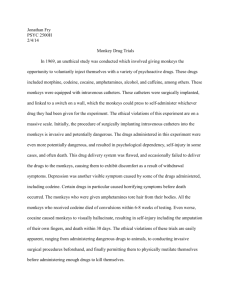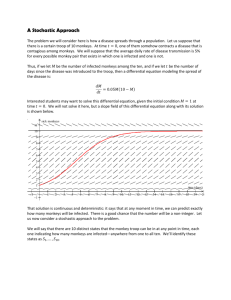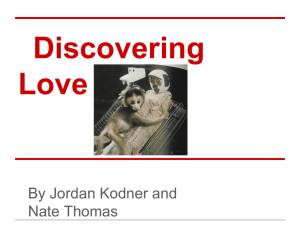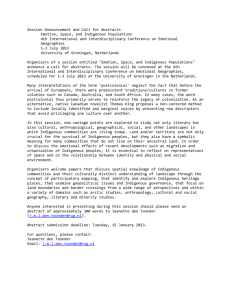Bibliography 4
advertisement
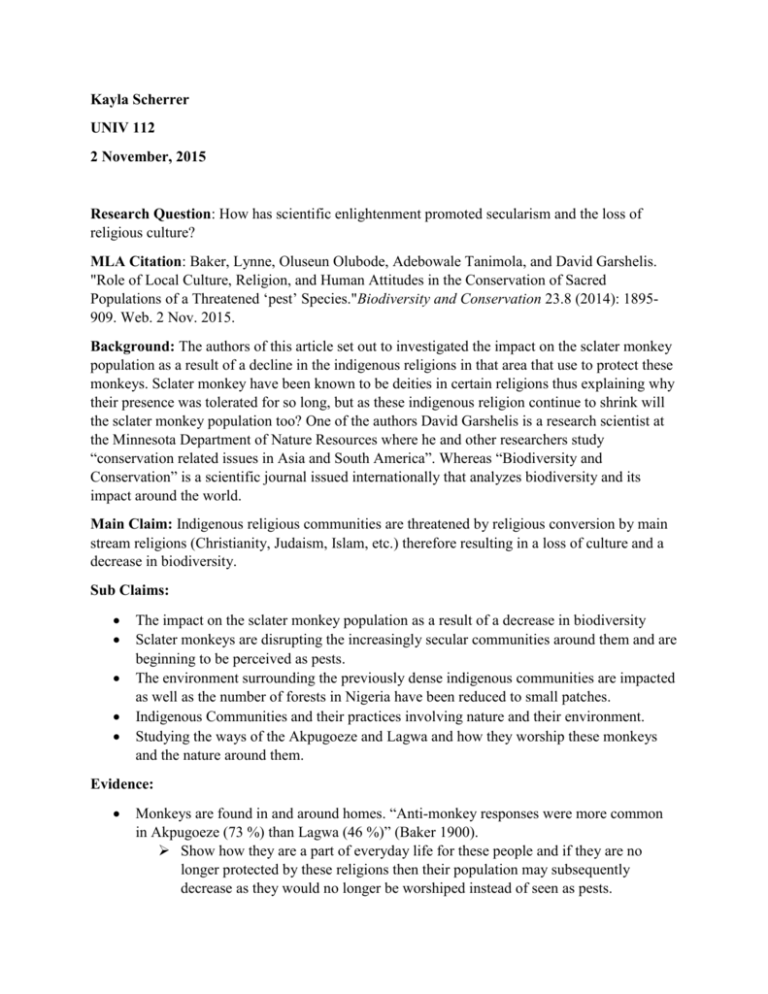
Kayla Scherrer UNIV 112 2 November, 2015 Research Question: How has scientific enlightenment promoted secularism and the loss of religious culture? MLA Citation: Baker, Lynne, Oluseun Olubode, Adebowale Tanimola, and David Garshelis. "Role of Local Culture, Religion, and Human Attitudes in the Conservation of Sacred Populations of a Threatened ‘pest’ Species."Biodiversity and Conservation 23.8 (2014): 1895909. Web. 2 Nov. 2015. Background: The authors of this article set out to investigated the impact on the sclater monkey population as a result of a decline in the indigenous religions in that area that use to protect these monkeys. Sclater monkey have been known to be deities in certain religions thus explaining why their presence was tolerated for so long, but as these indigenous religion continue to shrink will the sclater monkey population too? One of the authors David Garshelis is a research scientist at the Minnesota Department of Nature Resources where he and other researchers study “conservation related issues in Asia and South America”. Whereas “Biodiversity and Conservation” is a scientific journal issued internationally that analyzes biodiversity and its impact around the world. Main Claim: Indigenous religious communities are threatened by religious conversion by main stream religions (Christianity, Judaism, Islam, etc.) therefore resulting in a loss of culture and a decrease in biodiversity. Sub Claims: The impact on the sclater monkey population as a result of a decrease in biodiversity Sclater monkeys are disrupting the increasingly secular communities around them and are beginning to be perceived as pests. The environment surrounding the previously dense indigenous communities are impacted as well as the number of forests in Nigeria have been reduced to small patches. Indigenous Communities and their practices involving nature and their environment. Studying the ways of the Akpugoeze and Lagwa and how they worship these monkeys and the nature around them. Evidence: Monkeys are found in and around homes. “Anti-monkey responses were more common in Akpugoeze (73 %) than Lagwa (46 %)” (Baker 1900). Show how they are a part of everyday life for these people and if they are no longer protected by these religions then their population may subsequently decrease as they would no longer be worshiped instead of seen as pests. Shrines are dedicated to these monkeys as they are seen as deities. “Only eight respondents claimed to be adherents of the traditional religion and because religion was correlated with other variables, such presence of a household shrine (v2 = 63.18, df = 1, p\ 0.001)” (1899). These indigenous religions worship these monkeys as would a Hinduist would worship Ganesh (the elephant), therefore the killings of these monkeys would severely harm/ impact these indigenous communities as their gods would be hunted for game. Monkeys are generally unharmed in sacred groves, however they are decreasing in numbers, “averaging 2 ha in Akpugoeze and 0.5 ha in Lagwa; Baker et al. 2009” (1897). As missionaries continuously seek out to convert others to their religion, they also impact the number of indigenous communities that inhabit that area. Therefore with these conversions one can expect that there would be less sacred groves for these monkeys to reside in the future. An experiment was conducted in these two indigenous religious communities on whether they would prefer a community without or with the monkeys. This experiment concluded that more than half the population (59 %) would prefer a community without the monkeys, however 62% said they could tolerate them. This thus signifies the shift in spiritual attachment to these sacred monkeys as previously seen in other generations. Important Quotes: “The adoption of Christianity by indigenous societies has been often cited as leading to the erosion or loss of environmentally friendly beliefs and practices associated with local religions, such as the protection of sacred streams and forests or species through hunting taboos” (1895). This is shown above in the evidence explaining the decline in the acceptance of the sclater monkeys in these previously indigenous communities. More than half of the communities said they would prefer if the monkeys were elsewhere thus supporting the de-enlightenment theory in which indigenous beliefs and other religions will soon become extinct due to new modern behaviors. “In two Igbo communities, social taboos protect Sclaters monkey from being killed or eaten; these taboos are linked to indigenous religious beliefs and local folklore” (1896). Although there are taboos about the monkeys it does not seem to be enough as the previous beliefs about the monkeys seem to be disappearing with time. Thus what will happen in a few more years? Will these taboos be gone, or will they continue for a few more generations until this indigenous religion dies out or adapts to modern society. “Populations protected in this way are often considered under threat due to religious conversion” (1896). As missionaries flood into third world countries the number of indigenous religions decreases as they convert numerous of people to their religion. Therefore losing bits of culture and biodiversity in the process. “We thus expected that both crop raiding and religious change would negatively affect people’s opinions of the monkeys and may result in increased persecution in the future” (1898). This quote was later proven in the article as they discovered those within the communities that protected the monkeys did not really enjoy the monkeys presence either as half of them said they would not mind if they were no longer there. Instead they see them as pest who eat their crops and destroy their properties. “Based on the individually significant models, the odds of preferring the presence of monkeys was lower for non-indigenes, residents who attended more church services, and residents who received most of their income from farming” (1900). This explains the more than half the population not wanting to live with the monkeys anymore. Those whom prefer not to have monkeys in the communities tend to not follow the religion or are farmers whose crops get destroyed by their presence. However those who are no longer part of the indigenous religion were they converted or never a part of it? Usefulness: This article is very useful because it contains a lot of facts about the evolution of indigenous religions and how biodiversity is decreasing in these communities. Also it shows how behaviors have changed over the years and also conducted an experiment to test if biodiversity was actually affected in this community, which it was.
